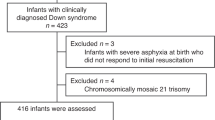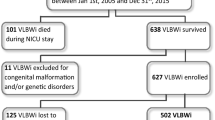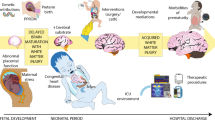Abstract
Objective:
The results from our previous trial revealed that infants with delayed cord clamping (DCC) had significantly lesser intraventricular hemorrhage (IVH) and late-onset sepsis (LOS) than infants with immediate cord clamping (ICC). A priori, we hypothesized that infants with DCC would have better motor function by 7 months corrected age.
Study Design:
Infants between 24 and 31 weeks were randomized to ICC or DCC and follow-up evaluation was completed at 7 months corrected age.
Result:
We found no differences in the Bayley Scales of Infant Development (BSID) scores between the DCC and ICC groups. However, a regression model of effects of DCC on motor scores controlling for gestational age, IVH, bronchopulmonary dysplasia, sepsis and male gender suggested higher motor scores of male infants with DCC.
Conclusion:
DCC at birth seems to be protective of very low birth weight male infants against motor disability at 7 months corrected age.
This is a preview of subscription content, access via your institution
Access options
Subscribe to this journal
Receive 12 print issues and online access
$259.00 per year
only $21.58 per issue
Buy this article
- Purchase on Springer Link
- Instant access to full article PDF
Prices may be subject to local taxes which are calculated during checkout


Similar content being viewed by others
References
Aladangady N, McHugh S, Aitchison TC, Wardrop CA, Holland BM . Infants’ blood volume in a controlled trial of placental transfusion at preterm delivery. Pediatrics 2006; 117 (1): 93–98.
Rabe H, Reynolds G, Diaz-Rossello J . Early versus delayed umbilical cord clamping in preterm infants. Cochrane Database Syst Rev 2004; (3): CD003248.
Rabe H, Reynolds G, Diaz-Rossello J . A systematic review and meta-analysis of a brief delay in clamping the umbilical cord of preterm infants. Neonatology 2008; 93 (2): 138–144.
Mercer J, McGrath M, Hensman A, Silver H, Oh W . Immediate and delayed cord clamping in infants born between 24 and 32 weeks: a pilot randomized controlled trial. J Perinatol 2003; 23 (6): 466–472.
Nelle M, Fischer S, Conze S, Beedgen B, Brischke EM, Linderkamp O . Effects of later cord clamping on circulation in prematures (Abstract). Pediatr Res 1998; 44: 420.
Rabe H, Wacker A, Hulskamp G, Homig-Franz I, Jorch G . Late cord clamping benefits extrauterine adaptation. Pediatr Res 1998; 44: 454.
Kinmond S, Aitchison TC, Holland BM, Jones JG, Turner TL, Wardrop CA . Umbilical cord clamping and preterm infants: a randomized trial. Br Med J 1993; 306: 172–175.
Ibrahim H, Krouskop R, Lewis D, Dhanireddy R . Placental transfusion: umbilical cord clamping and preterm infants. J Perinat 2000; 20: 351–354.
Oh W, Carlo W, Fanaroff AA, McDonald S, Donovan EF, Poole K et al. Delayed cord clamping in preterm infants—a pilot randomized controlled trial. Pediatr Res 2002; 51 (4 Suppl): 365–366.
Strauss RG, Mock DM, Johnson K, Mock NI, Cress G, Knosp L et al. Circulating RBC volume, measured with biotinylated RBCs, is superior to the Hct to document the hematologic effects of delayed versus immediate umbilical cord clamping in preterm neonates. Transfusion 2003; 43 (8): 1168–1172.
Hofmeyr GJ, Gobetz L, Bex PJ, Van der Griendt M, Nikodem C, Skapinker R et al. Periventricular/intraventricular hemorrhage following early and delayed umbilical cord clamping. A randomized controlled trial. Online J Curr Clin Trials 1993; Doc No 110: (2002 words; 26 paragraphs).
Hofmeyr GJ, Bolton KD, Bowen DC, Govan JJ . Periventricular/intraventricular haemorrhage and umbilical cord clamping. Findings and hypothesis. S Afr Med J 1988; 73 (2): 104–106.
Rabe H, Wacker A, Hulskamp G, Hornig-Franz I, Schulze-Everding A, Harms E et al. A randomised controlled trial of delayed cord clamping in very low birth weight preterm infants. Eur J Pediatr 2000; 159 (10): 775–777.
Mercer JS, Vohr BR, McGrath MM, Padbury JF, Wallach M, Oh W . Delayed cord clamping in very preterm infants reduces the incidence of intraventricular hemorrhage and late-onset sepsis: a randomized, controlled trial. Pediatrics 2006; 117 (4): 1235–1242.
Vohr BR, Wright LL, Poole WK, McDonald SA . Neurodevelopmental outcomes of extremely low birth weight infants <32 weeks’ gestation between 1993 and 1998. Pediatrics 2005; 116 (3): 635–643.
Nelle M, Zilow EP, Bastert G, Linderkamp O . Effect of Leboyer childbirth on cardiac output, cerebral and gastrointestinal blood flow velocities in full-term neonates. Am J Perinatol 1995; 12 (3): 212–216.
Bayley N . Bayley Scales of Infant Development-II. The Psychological Corportation: San Antonio, TX, 1993.
Vohr BR, Msall ME . Neuropsychological and functional outcomes of very low birth weight infants. Semin Perinatol 1997; 21 (3): 202–220.
Peterson BS, Vohr B, Staib LH, Cannistraci CJ, Dolberg A, Schneider KC et al. Regional brain volume abnormalities and long-term cognitive outcome in preterm infants. JAMA 2000; 284 (15): 1939–1947.
Bracewell M, Marlow N . Patterns of motor disability in very preterm children. Ment Retard Dev Disabil Res Rev 2002; 8 (4): 241–248.
Wardrop CAJ, Holland BM . The roles and vital importance of placental blood to the newborn infant. J Perinat Med 1995; 23: 139–143.
Sullivan MC, Margaret MM . Perinatal morbidity, mild motor delay, and later school outcomes. Dev Med Child Neurol 2003; 45 (2): 104–112.
Singer L, Yamashita T, Lilien L, Collin M, Baley J . A longitudinal study of developmental outcome of infants with bronchopulmonary dysplasia and very low birth weight. Pediatrics 1997; 100 (6): 987–993.
Northway Jr WH, Moss RB, Carlisle KB, Parker BR, Popp RL, Pitlick PT et al. Late pulmonary sequelae of bronchopulmonary dysplasia. N Engl J Med 1990; 323 (26): 1793–1799.
Stoll BJ, Hansen NI, Adams-Chapman I, Fanaroff AA, Hintz SR, Vohr B et al. Neurodevelopmental and growth impairment among extremely low-birth-weight infants with neonatal infection. JAMA 2004; 292 (19): 2357–2365.
Elsmen E, Hansen Pupp I, Hellstrom-Westas L . Preterm male infants need more initial respiratory and circulatory support than female infants. Acta Paediatr 2004; 93 (4): 529–533.
Hintz SR, Kendrick DE, Vohr BR, Kenneth Poole W, Higgins RD, For The Nichd Neonatal Research N. Gender differences in neurodevelopmental outcomes among extremely preterm, extremely-low-birthweight infants. Acta Paediatr 2006; 95 (10): 1239–1248.
Constable RT, Ment LR, Vohr BR, Kesler SR, Fulbright RK, Lacadie C et al. Prematurely born children demonstrate white matter microstructural differences at 12 years of age, relative to term control subjects: an investigation of group and gender effects. Pediatrics 2008; 121 (2): 306–316.
Derzbach L, Treszl A, Balogh A, Vasarhelyi B, Tulassay T, Rigo J . Gender dependent association between perinatal morbidity and estrogen recepto-alpha Pvull ploymorphism. J Perinat Med 2005; 33 (5): 461–462.
Frazier M, Werthammer J . Post-resuscitation complication in term neonates. J Perinatol 2007; 27 (2): 82–84.
Castro L, Yolton K, Haberman B, Roberto N, Hansen NI, Ambalavanan N et al. Bias in reported neurodevelopmental outcomes among extremely low birth weight survivors. Pediatrics 2004; 114 (2): 404–410.
Acknowledgements
We thank the parents and the staff who participated in this study. Their trust and cooperation were essential to our success. We would also like to thank Richard Tucker, Department of Pediatrics, Alpert Medical School of Brown University, Providence, RI, for his expert assistance with data analyses and interpretation. This study was supported by the National Institute of Health, National Institute for Nursing Research, K23 NR00078.
Author information
Authors and Affiliations
Corresponding author
Rights and permissions
About this article
Cite this article
Mercer, J., Vohr, B., Erickson-Owens, D. et al. Seven-month developmental outcomes of very low birth weight infants enrolled in a randomized controlled trial of delayed versus immediate cord clamping. J Perinatol 30, 11–16 (2010). https://doi.org/10.1038/jp.2009.170
Received:
Revised:
Accepted:
Published:
Issue Date:
DOI: https://doi.org/10.1038/jp.2009.170
Keywords
This article is cited by
-
Successful implementation of an intracranial hemorrhage (ICH) bundle in reducing severe ICH: a quality improvement project
Journal of Perinatology (2019)
-
Early versus delayed umbilical cord clamping on maternal and neonatal outcomes
Archives of Gynecology and Obstetrics (2019)
-
Placental transfusion in preterm neonates of 30–33 weeks’ gestation: a randomized controlled trial
Journal of Perinatology (2018)
-
Predictive factors and practice trends in red blood cell transfusions for very-low-birth-weight infants
Pediatric Research (2016)
-
One-time umbilical cord milking after cord cutting has same effectiveness as multiple-time umbilical cord milking in infants born at <29 weeks of gestation: a retrospective study
Journal of Perinatology (2015)



